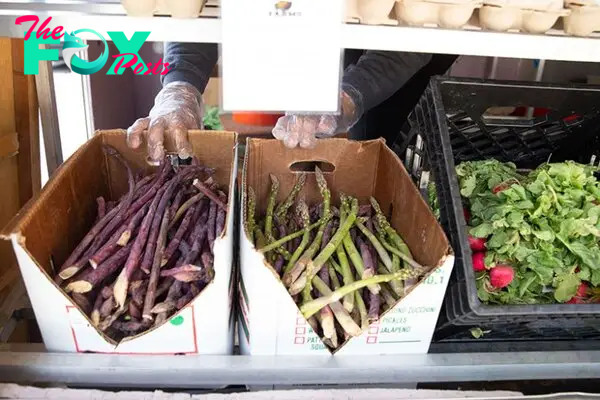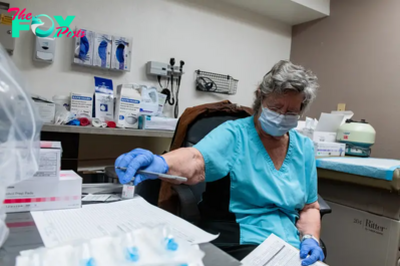Health
A Mesa County program meets people — and their produce needs — where they are
In the parking lot of Garden Village Apartments in Grand Junction, a 20-foot trailer with side-panel windows displayed racks of fresh chard, lettuce, cucumbers, celery, potatoes and dried pinto beans on an April morning. It was early in the growing season, and that day’s bounty, much of it greenhouse-grown, was from Early Morning Orchard, a producer and distributor for small, regional farms throughout Colorado.
Longtime resident Ida Valdez used a walker to approach the Harvest Mobile Market after seeing a flyer inside her apartment complex advertising the event. The Harvest Mobile Market is a Community Food Bank of Grand Junction pilot program designed to bring fresh, locally grown produce to low-income neighborhoods where transportation barriers often exist.
Valdez, 76, used to walk the few miles to the nearest grocery store, but now she calls a cab or catches a ride with a relative — which isn’t always convenient, she said. Valdez has never had a driver’s license.
Valdez and her husband moved from Tennessee to Grand Junction 15 years ago. “My husband did all the driving,” she said. “Then he got sick with cancer. He passed away 11 years ago, so I got stuck here.
“Before my legs got bad, I walked everywhere. My blood is not circulating the way it should. It’s hard to walk; sometimes, my legs go numb.”
Chelsea Craine, the food bank’s program operations director, invited Valdez to fill a bag with whatever she wanted. “Have a blessed day,” Valdez said as she turned back toward her apartment, a bag of vegetables resting on the seat of her walker.
The Community Food Bank of Grand Junction, serving Mesa County, operates a food pantry three days a week. Since launching the Harvest Mobile Market pilot in 2023, staff have been collecting data and gauging interest for a permanent and sustainable mobile market selling Colorado-grown produce at affordable prices.

Mobile market helps between long trips on foot to Walmart each month
Leeanne and Jerimiah Hargis and three of their seven children came to the Garden Village mobile market to collect some free produce and eggs. The family doesn’t own a car, so once a month, Leanne walks 3.5 miles roundtrip to Walmart or a little farther to City Market, pulling a wagon to haul groceries. In between trips to the store, the family visits the Community Food Bank pantry when they can carpool with Jerimiah’s mother, who owns a car.
Leanne said she’d be willing to pay for the food if a regular mobile market was established, especially if it accepted Supplemental Nutrition Assistance Program benefits. “It would save on gas. It would be saving my legs,” she said.
Community Food Bank Executive Director Alisha Wenger said the Harvest Mobile Market directly resulted from community feedback regarding transportation barriers and a desire for more fresh food. While the food is free for clients during the pilot phase, Wenger’s goal is to make the program sustainable via a paid market in 2025 that would accept SNAP and Double Up Food Bucks, as well as provide a flexible pricing model for low-income and low-access neighborhoods.
The food bank’s community advisory board —1 0 current or former food pantry clients — helped design the pilot effort and affirmed that the produce should not be free in a permanent mobile market program.
“There’s more dignity and accountability in this model. It’s not just a charitable act,” Wenger said. “They are also supporting local farmers.”
Community Food Bank is purchasing produce from Early Morning Orchard in Palisade and Green Junction Farmstead in Clifton with funding from the USDA’s Local Food Purchase Assistance Cooperative Agreement Program, which supports local, regional and underserved producers. To date, Community Food Bank has spent $159,547 in 2023 and 2024 at local producers to bring more fresh local foods to the food pantry, Wenger said.
Wenger, 38, grew up in Clifton in a food-insecure household. She said she never had peaches growing up, even though they’re grown in nearby Palisade.
Front-line food system workers and migrant farmworkers, too, are often food insecure, Wenger said. They usually don’t have access to the food they produce, with much of it going to more affluent markets in the central mountain region and the Front Range.
“It’s heartbreaking; it’s your culture, community, but you’re priced out of it,” she said. “I have a deep, personal understanding of the need and what it feels like— it’s sort of like being backed into a corner with no good options.”

According to the Mesa County Blueprint to End Hunger, 20,500 people (14% of Mesa County residents) are considered food insecure. In Mesa County Valley School District, 52% of children qualify for free or reduced-price lunch. The Community Food Bank has served more than 11,000 unique individuals in the past year, or 7% of the county population.
Carrie Gillette, 67, is a community advisory board member and food pantry client. She volunteered at a Harvest Mobile Market event outside a physician’s office in early April.
-

 Health1d ago
Health1d agoTeens Are Stuck on Their Screens. Here’s How to Protect Them
-

 Health1d ago
Health1d agoHow Pulmonary Rehab Can Help Improve Asthma Symptoms
-

 Health1d ago
Health1d ago10 Things to Say When Someone Asks Why You’re Still Single
-

 Health2d ago
Health2d agoThe Surprising Benefits of Talking Out Loud to Yourself
-

 Health2d ago
Health2d agoDoctor’s bills often come with sticker shock for patients − but health insurance could be reinvented to provide costs upfront
-

 Health3d ago
Health3d agoWhat an HPV Diagnosis Really Means
-

 Health3d ago
Health3d agoThere’s an E. Coli Outbreak in Organic Carrots
-

 Health4d ago
Health4d agoCOVID-19’s Surprising Effect on Cancer



























